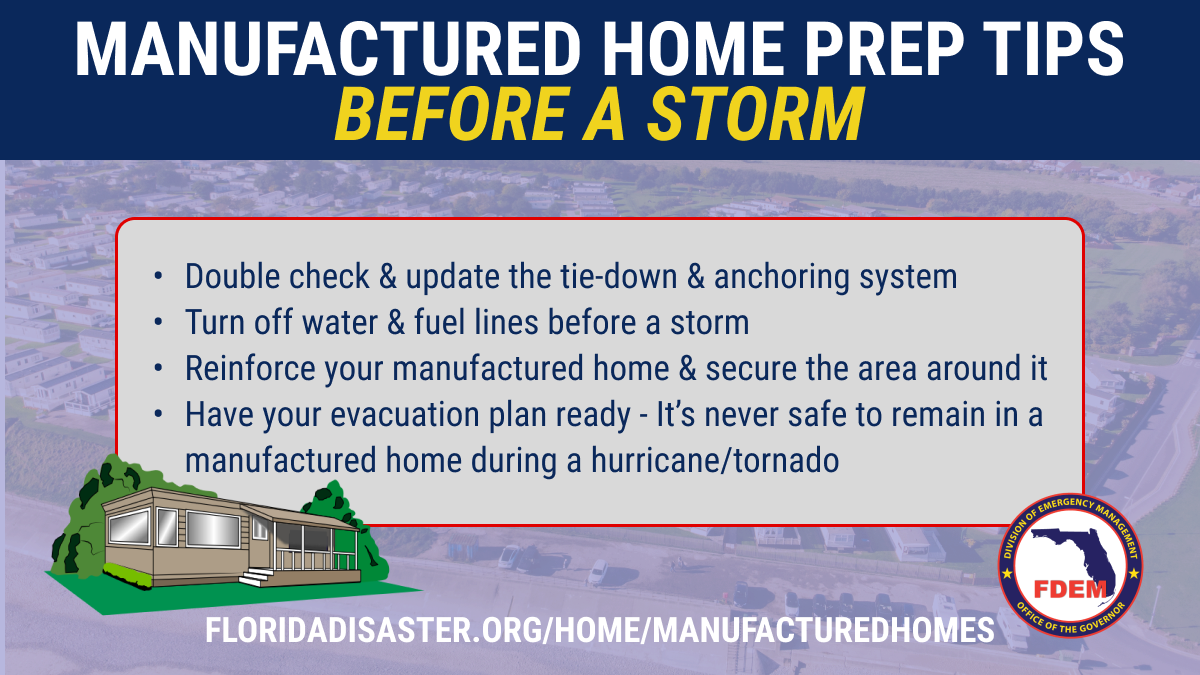Make a Plan for Manufactured Homes

The best way to protect yourself and your family is to have a disaster plan that fits your needs. If you live in a manufactured home there are steps that can be taken to better protect your property and recover efficiently after a disaster.
Develop a comprehensive disaster plan before a storm threatens your area. For manufactured home homeowners, many of the precautionary measures take time and planning that should be done well before a storm forms. It is important to budget time for the following preparations:
Check your insurance. Insurance for manufactured homes does not inherently cover damage related to flooding. Review your policy for coverage details and contact your insurance agent if you have any questions. To protect your home and valuables, make sure you are covered and take pictures or video of your possessions for insurance claims.
Double check and update the tie-down and anchoring system that is keeping your manufactured home grounded. Manufactured homes are particularly vulnerable to high winds displacing the home. Checking the quality of these systems before a disaster is essential to being prepared. If you have questions about your anchoring system, contact your local building department. Factors to consider include:
- Different styles of manufactured homes require different tie-down and anchoring systems
- These systems worsen over time and should be updated due to wear and tear
- The best way to make sure you are ready for severe weather, is to have an expert evaluate your home to see if repairs are needed
- Tie-down installation requirements are set forth in Florida Administrative Code 15C-1
Every homeowner should have a disaster preparedness kit. In addition to what should be in every disaster kit, manufactured home homeowners should consider including tools needed to reinforce areas of their homes like anchors, wall joints, and boarding up windows and glass doors. There should also be extra consideration for materials needed, for child locks for drawers and cabinets, and ways to secure fragile items to prevent any of these from being displaced during a storm.
Turn off water and fuel lines before a storm.Water can be turned off at the water meter. Natural/LP gas can be turned off at the regulator or tank. Power can be turned off at the main breaker in the electrical/breaker panel.
Secure the area around the home. Outside décor can become harmful debris to the home during a storm. It is best to see what can be stored somewhere safe or better attached to the home to prevent further damage. Trimming trees and removing yard debris before a storm occurs is another precautionary measure that should be taken to mitigate damage during severe weather. If you are concerned with the integrity of an awning, carport, and similarly attachments, contact your local building department for an inspection. Ensuring that the address of the mobile home is highly visible is a precautionary measure that makes recovery easier.
Have your evacuation plan ready. It is never safe to remain in a mobile home during a high wind event such as a tropical storm, hurricane, thunderstorm, or tornado. Knowing where and when to evacuate while also having your disaster plan, is the best way protect your family and home.
Reinforce your mobile home. Extra ways to strengthen your mobile home include:
- Have your roof and soffits inspected for damage and weakness to wind and rain.
- Installing storm shutters
Look into mobile home assistance resources. There may be programs available in your area or offered by the state that can help with costs and services related to securing your mobile home. One such program is Gulf Coast State College Mobile Home Tie-Down Program.
- For more information concerning the Mobile Home Tie-Down Program, contact Gulf Coast State College at 448-201-6882, visit www.gulfcoast.edu/tiedownprogram or email tiedownprogram@gulfcoast.edu.

